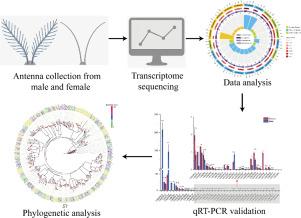Identification and sex-biased expression analysis of olfactory-related genes in Lymantria dispar based on transcriptome and qRT-PCR
IF 2.2
2区 生物学
Q4 BIOCHEMISTRY & MOLECULAR BIOLOGY
Comparative Biochemistry and Physiology D-Genomics & Proteomics
Pub Date : 2025-09-10
DOI:10.1016/j.cbd.2025.101634
引用次数: 0
Abstract
Lymantria dispar, a destructive forest pest, poses a significant threat to forest ecosystems. Olfaction plays a pivotal role in mate finding, host location, and oviposition site selection in insects. This study aimed to systematically characterize olfactory-related genes in adult L. dispar and examine sex-specific expression profiles, shedding light on the molecular mechanisms of olfactory perception in this species. Antennal transcriptomes of male and female L. dispar were sequenced, generating 36.61 Gb of high-quality clean data. A total of 134 olfactory-related genes were identified, including 40 odorant receptors (ORs), 12 gustatory receptors (GRs), 20 ionotropic receptors (IRs), 17 chemosensory proteins (CSPs), 38 odorant-binding proteins (OBPs), 3 odorant-degrading enzymes (ODEs), and 4 sensory neuron membrane proteins (SNMPs). Relative expression levels of these genes were validated by qRT-PCR, revealing that 28 genes were significantly upregulated in female antennae, while 32 genes exhibited higher expression in males. These findings aligned closely with the transcriptome data. This study provides a comprehensive characterization of olfactory-related genes in L. dispar antennae and uncovers their sex-biased expression, offering valuable insights into the molecular mechanisms of pheromone detection and other olfactory-driven behaviors in this pest species.

基于转录组和qRT-PCR的发散Lymantria嗅觉相关基因鉴定及性别偏倚表达分析。
Lymantria dispar是一种破坏性森林害虫,对森林生态系统构成重大威胁。嗅觉在昆虫的择偶、寄主定位和产卵地点选择中起着关键作用。本研究旨在系统地表征成虫嗅觉相关基因,并分析其性别特异性表达谱,以揭示该物种嗅觉感知的分子机制。对雄性和雌性白蛉的触角转录组进行了测序,获得了36.61 Gb的高质量干净数据。共鉴定出134个嗅觉相关基因,包括40个气味受体(ORs)、12个味觉受体(GRs)、20个嗜离子受体(IRs)、17个化学感觉蛋白(CSPs)、38个气味结合蛋白(OBPs)、3个气味降解酶(ODEs)和4个感觉神经元膜蛋白(snp)。通过qRT-PCR验证了这些基因的相对表达水平,发现28个基因在雌性触角中显著上调,32个基因在雄性触角中表达较高。这些发现与转录组数据密切相关。本研究全面表征了异叶夜蛾嗅觉相关基因,揭示了其性别偏倚表达,为揭示异叶夜蛾信息素检测和其他嗅觉驱动行为的分子机制提供了有价值的见解。
本文章由计算机程序翻译,如有差异,请以英文原文为准。
求助全文
约1分钟内获得全文
求助全文
来源期刊
CiteScore
5.10
自引率
3.30%
发文量
69
审稿时长
33 days
期刊介绍:
Comparative Biochemistry & Physiology (CBP) publishes papers in comparative, environmental and evolutionary physiology.
Part D: Genomics and Proteomics (CBPD), focuses on “omics” approaches to physiology, including comparative and functional genomics, metagenomics, transcriptomics, proteomics, metabolomics, and lipidomics. Most studies employ “omics” and/or system biology to test specific hypotheses about molecular and biochemical mechanisms underlying physiological responses to the environment. We encourage papers that address fundamental questions in comparative physiology and biochemistry rather than studies with a focus that is purely technical, methodological or descriptive in nature.

 求助内容:
求助内容: 应助结果提醒方式:
应助结果提醒方式:


